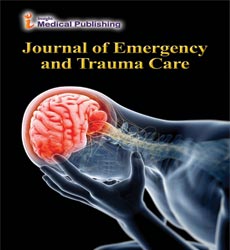Measurements of Crowding: Pediatric Emergency Wards
Shan KojiKa*
Department of Psychological Trauma, University of Pretoria, Pretoria, South Africa
- *Corresponding Author:
- Shan KojiKa
Department of Psychological Trauma, University of Pretoria, Pretoria, South Africa
E-mail: Shan.kojika@email.sa
Received Date: September 3, 2021; Accepted Date: September 17, 2021; Published Date: September 24, 2021
Citation: KoKjiKa S (2021) Measurements of Crowding: Pediatric Emergency Wards. J Emerg Trauma Care Vol.6 No.1:e026.
Editorial Note
The lack of recognized instruments to measure overcrowding that encompasses the unique characteristics of pediatric emergency rooms creates a deficit in ongoing efforts to identify and evaluate solutions to this growing problem. We examined 4 studies that reported on the development and testing of crowding measures in the multidimensional pediatric emergency department. Two studies included models (PEDOCS, SOTUPED) that measured factors indicative or contributing to overcrowding. A third study developed a model that maps the flow of patients through the pediatric emergency room. The final study modelled the extent of the physician's workload, especially when that load is high, when a bottleneck is likely, based on patient arrivals, complaints and conditions, and tests requested. 4,444 instruments have been developed and studied in depth to measure overcrowding in adult emergency rooms. However, there is no consensus on which instrument should be standard, although there are many instruments that can be evaluated in adult education institutions in the hope of gaining validity for a standard instrument in the future. The state of the art for measuring overcrowding differs significantly in pediatric emergency rooms. For pediatric emergency medicine, there has been less research on techniques to measure overcrowding
There are general principles and common methods for measurements of overcrowding in emergency rooms in adults and children, but measurements developed for the adult setting are not the same. They take into account. Of pediatric emergency rooms and how the causes and effects of overcrowding in emergency medicine differ widely in adults and children. Compared to 2017 data from the academy of administrators in academic emergency medicine/association of academic chairs in emergency medicine operations regarding patient focus, volume, length of stay among 52 adults and 17 pediatric patients in ward emergency in the United States (USA). Reference survey: Relevant differences observed in this study included that adult emergency rooms had higher mean annual patient visits. More hospitalized patients transported by EMS, clinical staff, behavioral health patients, visits to be left unseen (LWBS), admissions and acutely visual visits.
Previous attempts to measure overcrowding in pediatric EDs were based on one-dimensional or proxy measurements, or used individual components selected from input-output-output frameworks. Although such frameworks consist of multiple, separate, and one-dimensional metrics, the metrics have not been combined or integrated to produce a quantifiable value that can indicate when an emergency room is overcrowded. Common one-dimensional or single surrogates that have been used to measure pediatric clucking in the ED are: LWBS rates, average length of ED stay, number of people admitted to the ED, and time spent in the ED. approach in the emergency department, occurrence of ambulance diversions, acuity in the emergency department (including total count, admission rate, total number of admissions and proportion of non-urgent patients), daily volume of patients in the emergency room and accumulated daily admission time in the emergency room, occupancy rate of stay >6 hours and volume of patients in the emergency room.
The lack of recognized tools for measuring overcrowding that taken into account the unique characteristics of pediatric emergency rooms creates a deficit in ongoing efforts to find and evaluate solutions to this growing problem. To overcome this deficit and guide future research efforts, this was conducted to examine the scope of existing research to develop and evaluate multidimensional or composite instruments to measure the specific overcrowding of pediatric emergency rooms.
Open Access Journals
- Aquaculture & Veterinary Science
- Chemistry & Chemical Sciences
- Clinical Sciences
- Engineering
- General Science
- Genetics & Molecular Biology
- Health Care & Nursing
- Immunology & Microbiology
- Materials Science
- Mathematics & Physics
- Medical Sciences
- Neurology & Psychiatry
- Oncology & Cancer Science
- Pharmaceutical Sciences
